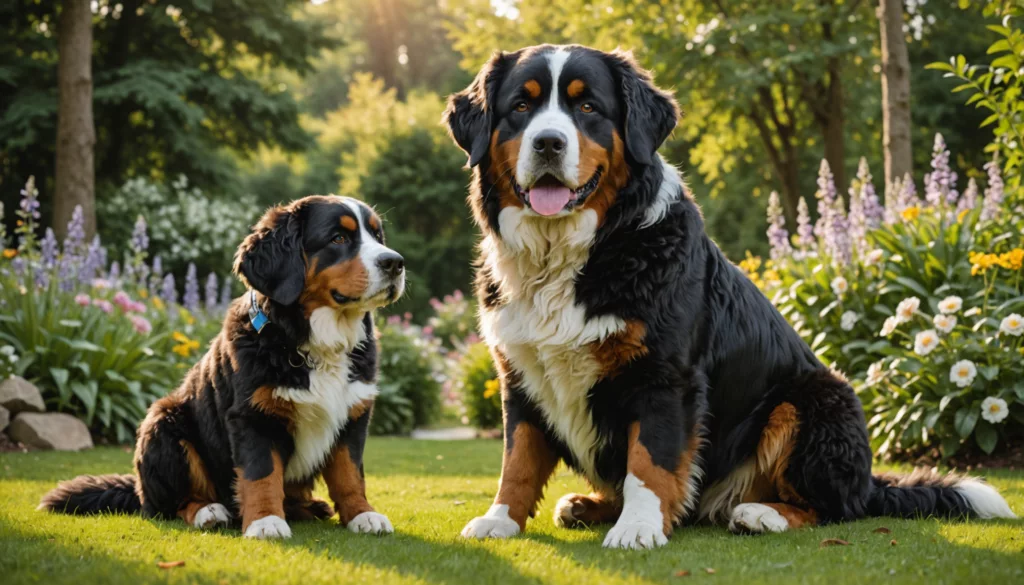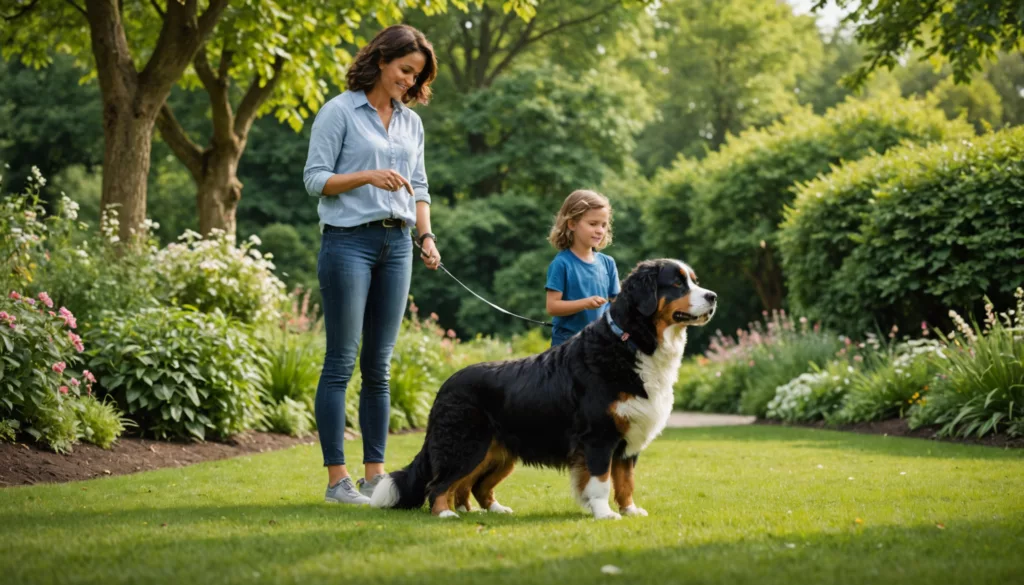When it comes to gentle giants, the Bernese Mountain Dog bite force is something every dog lover should understand. These lovable Swiss mountain dogs pack a powerful bite ranging from 200 to 400 PSI (pounds per square inch), making them strong but not among the most forceful biters in the canine world.
Understanding your Bernese’s bite strength isn’t just about numbers – it’s about keeping both your furry friend and family safe through proper training and socialization. In this guide, we’ll explore how these friendly giants compare to other breeds, discover the factors that influence their bite strength, and learn essential training tips to ensure your Bernese grows into a well-behaved companion. Whether you’re a current owner or considering adding one of these beautiful dogs to your family, you’ll find everything you need to know about managing and appreciating your Bernese Mountain Dog’s natural abilities.
Understanding the Bernese Mountain Dog Bite Force

What is the Bite Force of a Bernese Mountain Dog?
You can expect a Bernese Mountain Dog bite force of about 200 to 250 pounds per square inch (PSI). Some studies place the range of 200 to 400 PSI, but variations arise because testing methods differ. This mountain dog bite force PSI suggests moderate power compared to other dog breeds with stronger guarding instincts. Even so, this breed’s capacity remains impressive for tasks such as pulling carts through the Swiss Alps.
According to Frontiers in Veterinary Science, jaw muscle development and skull shape are the main factors behind this force. Proper training reinforces calm behavior, ensuring you rarely see full bite capability in daily life.
Comparing the Bite Force of Bernese Mountain Dogs to Other Breeds
When stacked against other dog breeds, Bernese Mountain Dogs show a bite force on par with German Shepherds (about 238 PSI). They are still quite powerful compared to average family pets, yet well below breeds such as Kangals, which can reach 743 PSI. These differences depend on each dog’s genetics, body size, and instinct.
| Dog Breed | Bite Force (PSI) |
|---|---|
| Kangal | 743 |
| German Shepherd | 238 |
| Bernese Mountain Dog | 200–250 |
| Labrador Retriever | 230 |
| Average Family Dog | 150–200 |
PSI Measurement: How the Force of a Bernese Mountain Compares
This range of 200 to 400 PSI helps the Bernese Mountain Dog guard livestock or work as an all-around farm companion. The breed’s loyalty and protective nature come from centuries of driving cattle in harsh conditions. Modern tests rely on calibrated equipment, but final readings vary based on each dog’s environment, age, and health.
Factors Affecting Bite Force Strength
Physical traits and behavior both shape bite strength. Adult Bernese Mountain Dogs often weigh between 70 and 115 pounds. Their jaw muscles, skull size, and daily nutrition can impact power. Socialization, early positive reinforcement, and a stable environment also guide more gentle behavior. Even though dogs have a strong natural instinct, a Bernese Mountain Dog’s affectionate temperament usually prevents aggressive incidents.
The Temperament and Behavior of Bernese Mountain Dogs

This Breed’s Temperamental Characteristics
Bernese Mountain Dogs often display a calm and affectionate nature American Kennel Club. They remain good with children and thrive as loyal companions in many different environments. Their strong willingness to please, combined with moderate energy levels, makes them capable pets for families seeking a steady guardian.
Biting Behavior: When and Why Do Bernese Mountain Dogs Bite?
Bernese Mountain Dogs seldom nip unless they sense a physical threat or sudden pain. Experts estimate this breed’s mountain dog bite force psi within the range of 200 to 400 pounds per square inch, which is still quite powerful compared to other dog breeds, so incidents can cause bite wounds if handled improperly.
Most cases involve fear, territorial instincts, or protective behavior. They stay calm in most situations but may become aggressive when guarding resources or defending family members WebMD Pets.
Importance of Socialization in Reducing Bite Risks
Proper training and socialization at a young age helps limit unwanted biting behavior. Early introduction to different people, pets, and environments builds confidence and reduces future aggressive behavior. Positive reinforcement methods encourage a Bernese Mountain Dog puppy to learn appropriate responses without fear. Consistent guidance from a certified dog trainer can further foster a stable personality.
Signs of Aggression and Prevention Methods
Subtle signs, such as a stiff posture or low growl, often indicate brewing aggression. Observing a dog’s body language and addressing triggers can prevent an incident before it escalates. Routine veterinary check-ups ensure pain or illness does not fuel negative behaviors. Combining ample exercise with positive training techniques helps keep a Bernese Mountain Dog playful and well-adjusted.
Origin and Size of the Bernese Mountain Dog

Bernese Mountain Dogs originated in the canton of Bern, Switzerland. They once served as farm helpers in the Swiss Alps, where they pulled carts and guided livestock across difficult terrain. Over time, they became valued for their dependability and calm nature.
Historical Background of the Breed
This breed’s documented history dates back to the late 1800s, when Swiss farmers relied on them for daily tasks such as pulling carts. In 1907, the Swiss Kennel Club recognized them as a distinct working breed. Today, they retain a reputation for being both powerful and gentle, especially when interacting with other dog breeds or farm animals.
Size and Weight: How It Impacts Bite Force
Males often measure 25 to 27.5 inches at the shoulder and weigh between 80 and 120 pounds. Females stand 23 to 26 inches and weigh 70 to 100 pounds. A larger frame typically supports a stronger jaw and broader head. These traits contribute to a Bernese Mountain Dog bite force that is still quite powerful. While exact mountain dog bite force psi readings vary, some sources suggest a range of 200 to 400 psi.
| Feature | Males | Females |
|---|---|---|
| Height | 25–27.5 inches | 23–26 inches |
| Weight | 80–120 pounds | 70–100 pounds |
| Head Size | Broad | Slightly smaller |
The Role of Genetics in Biting Behavior
This breed’s farm-dog heritage explains its controlled bite inhibition. Early work included herding livestock and pulling carts while offering a protective presence. Over generations, breeders emphasized gentle instincts and calm responses to avoid causing bite wounds or unwanted aggression. These genetic factors allow many puppies to develop into loyal, capable pets with a balanced instinct for guarding livestock without excessive force.
Modern Breeding Standards and Health Considerations
Breeding programs today focus on maintaining stable temperaments. Health evaluations check skeletal alignment and jaw structure, which can influence bite strength. Responsible breeders also prioritize proper training and socialization to prevent aggressive behavior. Although Bernese Mountain Dogs have a strong bite, many remain affectionate and reliable companions when given an environment that supports positive behaviors.
Risks Associated with the Bernese Mountain Dog Bite

Bernese Mountain Dogs rarely cause serious bite incidents, but certain factors can increase the likelihood of aggressive behavior. This section explores how environment, misunderstandings, and preventive measures influence bite risk.
Understanding the Factors Influencing Bite Risk
Inadequate socialization during the critical puppy phase of 8 to 16 weeks can raise the chance of a bite incident. Pain from hidden health problems may trigger defensive reactions, and sudden fear or territorial responses add to the risk. Despite their gentle nature, these dogs have a strong instinct to protect loved ones. A Bernese Mountain Dog bite force can fall within the range of 200 to 400 psi, though exact mountain dog bite force psi measurements vary.
Common Misconceptions About the Breed and Biting
Some believe the breed’s large size means high aggression levels. However, experts note that size does not consistently predict aggression in dog breeds. Compared to other dog breeds, Bernese Mountain Dogs often show strong bite inhibition when raised with proper training and socialization. They remain affectionate and playful, even though they are still quite powerful and were once used for tasks such as pulling carts.
Expert Recommendations for Safe Interactions
Early socialization and positive reinforcement help limit unwanted biting behavior. Regular veterinary visits detect hidden pain, which can trigger defensive bites. Consistent commands and stable routines guide Bernese Mountain Dogs toward calm behavior around new people or pets. Proper training and socialization ensure they stay good with children while preserving their protective yet gentle nature.
Legal Considerations and Insurance Implications
This breed is not typically on restricted lists, so most homeowner’s insurance covers them. Local regulations vary, and documented evidence of proper training techniques reduces any liability concerns. Many owners consider Bernese Mountain Dogs ideal companions in family environments, provided they follow proactive precautions. Demonstrating consistent care and guidance helps avoid potential legal or insurance complications.
Evaluating the Bernese Mountain Dog’s Bite Force and Temperament

Bernese Mountain Dogs have a reputation for a powerful bite, yet they often display a gentle nature when guided through proper training. Some estimates place the mountain dog bite force psi within a range of 200 to 400 pounds per square inch, though exact measurements can vary. Early socialization and consistent bite inhibition work are crucial for preventing aggressive behavior and unwanted incidents.
Potential for Improvement: Training and Management Strategies
Structured training between 8 and 16 weeks is best for refining a puppy’s natural instinct and protective drive. Positive reinforcement methods, such as reward-based commands, help teach correct bite control and playful, rather than aggressive, behavior. Include daily socialization tasks such as pulling interaction with people, other dog breeds, and livestock to develop calm responses. Supplement sessions with mental stimulation like puzzle toys or short agility exercises.
- Consistent obedience practice to reinforce positive behaviors
- Short, frequent training sessions for better retention
- Regular observation to catch and redirect nipping triggers
American Kennel Club advises gentle methods to foster trustworthy companions. Additional details about canine behavior can be found at Wikipedia.
Why Understanding the Bernese Mountain Dog Is Vital for Owners
Adult Bernese Mountain Dogs typically weigh 70 to 115 pounds, creating a considerable capability for powerful bites. However, this breed tends to remain affectionate and family-oriented when socialized at a young age. Monitoring territorial instincts helps reduce potential bite wounds and other aggressive tendencies. Recognizing the dog’s strong work ethic also ensures enough physical activity to prevent destructive behaviors.
Professional Training Resources and Support
| Resource Type | Benefits | Best For |
|---|---|---|
| AKC Registered Trainers | In-depth breed understanding | First-time caretakers |
| Breed-Specific Programs | Focused strategies for Bernese traits | Maintaining bite inhibition |
| Professional Behaviorists | Customized solutions for complex issues | Severe or persistent aggression |
Your Bernese Mountain Dog demonstrates a moderate bite force, often measured within the range of 200 to 400 pounds per square inch (PSI). This Bernese Mountain Dog bite force stands in the middle when compared to other dog breeds of similar size. Even though these dogs have a strong jaw, they rarely show aggressive behavior when properly trained.
Early socialization is important, and it’s crucial for owners who want an affectionate companion. When you introduce your pup to diverse sights, sounds, and individuals at a young age, you encourage strong bite inhibition. Positive reinforcement and consistent commands also help prevent unwanted nipping or stronger bites.
Regular training builds loyalty and protective instincts without triggering unwanted aggression or territorial behavior. Professional guidance from a dog trainer or behaviorist can help you shape which tasks your dog can master, including pulling carts and guarding livestock. Proper dog food, ongoing veterinarian care, and a stable environment also keep your pet in good health.
Consistent exercise and mental stimulation reduce aggression and promote a balanced temperament. Bernese Mountain Dogs weigh between 70 and 115 pounds, so they are large yet playful companions. With proactive care, these dogs have a strong capacity to learn appropriate behaviors and remain gentle around children or other animals.
Conclusion
Bernese Mountain Dogs possess a bite force ranging from 200 to 400 PSI, which is considerable yet typical for their size. While these gentle giants have strong jaws, their naturally friendly temperament and loyalty make them wonderful family companions rather than aggressive guards. Understanding their bite force helps put their physical capabilities in perspective while highlighting the importance of proper training and socialization.
Early training, consistent positive reinforcement, and regular socialization are key to raising a well-behaved Bernese Mountain Dog. These lovable pets combine strength with a sweet disposition, making them excellent family dogs when given the right guidance and care. Whether you’re a current owner or considering bringing a Bernese Mountain Dog into your home, remember that their strength is balanced by their inherently gentle nature.
FAQs
1. What is the typical bite force of a Bernese Mountain Dog?
You may find that Bernese Mountain Dogs exert around 200 to 250 PSI (pounds per square inch) of force. Some estimates show a broader range of 200 to 400 PSI. Their powerful bite compares moderately to other dog breeds but rarely leads to aggressive behavior.
2. Are Bernese Mountain Dogs known for aggressive biting?
They are not prone to aggressive behavior. Most incidents occur only if they feel threatened or need to protect their environment. With proper training and socialization, this companion breed usually stays calm, playful, and affectionate.
3. How does their bite force compare to other dog breeds?
Bernese Mountain Dogs rank above some breeds yet below others with extreme bite strength. For example, they have a stronger bite than Golden Retrievers but a weaker bite than Rottweilers. Despite that range, they remain loyal pets, especially when you provide consistent boundaries.
4. When should you start bite inhibition training?
Bite inhibition training works best during puppyhood, around 8 to 14 weeks. Early socialization teaches pups to nip gently and respects their natural instinct to explore. Positive reinforcement helps them learn appropriate behaviors without unwanted aggression.
5. What are effective methods for preventing biting behavior?
You can introduce gentle play rules and discourage rough games that trigger a strong tendency to bite. Consistent commands and clear guidance help set solid boundaries. Praise positive behaviors and consult a dog trainer or behaviorist if biting persists.

